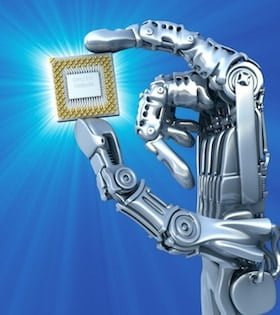 We live in transformative times. The sad fact is, many are unaware of that fact, and as a result, are missing out for opportunities for innovation.
We live in transformative times. The sad fact is, many are unaware of that fact, and as a result, are missing out for opportunities for innovation.
Bill Gates once observed that “most people overestimate the amount of change that will occur in two years and underestimate the change that will occur over ten years.”
Certainly that’s true today. All around us, there’s a tremendous amount of creative thinking occurring as people work to solve some of the biggest challenges of our times. Ten years from now, we’ll sit back in awe at some of the fascinating ideas that came to fruition.
Much of this transformation is coming about as we enter the next phase in our often unique relationship with technology –what we might call pervasive connectivity. Quite simply, everything around us is starting to “plug in” –and there are tremendous opportunities for change as this happens. To ensure that we capture these opportunities, business and government must ensure that they’ve got a good, solid technology infrastructure that can carry them into this odd new world.
Consider the issue of energy and the environment, and the revolution that is now underway in terms of intelligent building infrastructure. In the not too distant future, most residential and commercial properties will have an HVAC (heating, ventilation and air conditioning) infrastructure that has ‘gone smart.’ Right now, major industrial players are adding intelligence to the next generation of HVAC systems. We’re seeing remote monitoring and management through Internet-linked thermostats; better analysis and insight into energy usage through remote management of energy production assets ; rapid response to out-of-norm operations. In the not too distant future –maybe by the time you read this article –you’ll use a mobile application that will utilize its GPS connection to determine when you are getting close to home –and it will turn your furnace on.
Technologies such as these allow people to more actively control overall energy usage, and reduce the environmental impact of that use. There are broad benefits to society from encouraging the more rapid adoption of such technologies.
Then there’s the revolution in thinking that is occurring in the world of long-term seniors care. Clearly, the future challenges we face are pretty stark: a massive ramp-up in demand with a shortfall in available and planned units; a funding crisis brought about by plunging investment / housing values, and a bigger tax deficit as a result of the economic challenges of today; not to forget ongoing skills and staffing issues as the very same baby boomers exit the economy in staggering numbers.
So what’s going to happen? We’re starting to see some big, transformative thinking that involves a lot more community and family care. With this, we’ll witness the emergence of the concept of the “virtual retirement home.” By 2020, most seniors will live in their own homes, and their health conditions will be actively monitored by medical professionals through a network of intelligent bio-connectivity and other devices. We won’t have a lot of senior citizen homes — we’ll have virtual seniors networks.
Research is already well underway into the concept; at the University of Missouri, they’re actively working with technology that allows for the use of sensors and other technologies to monitor seniors living at home. Behavioral changes involving sleeping patterns, a reduction in physical activity or other changes can trigger contact; and remote medical devices will allow for routine blood pressure and other medical test.
Then there’s the transformation that is occurring throughout many industries as they learn to rethink the basic business models by which they operate. Think of efforts towards ‘Car 2.0′, which involves a fundamental reinvention of current transportation mindsets. There is a strong belief that we will see a reinvention of the auto industry as the restructuring occurs; particularly as Silicon Valley begins to laser-aim its focus at the next generation of business model. Contrast the thinking of Ford versus Honda. The former retools their plant annually, building several hundred thousand models of a particular vehicle, hoping it will sell. The latter can change things up on a dime, shifting production to meet changing consumer demand in as little as ten days. It’s that type of fundamental transformation that will help to encourage the economic recovery, because business organizations will be operating with far more agility and flexibility.
There are thousands of similar, low-key trends that put together, will have a huge impact on our future.
And here’s a key point: all of these trends involve connectivity and technology; intelligent infrastructure and the intelligent deployment of computing horsepower. We are already in the midst of the next phase of our march to the world of pervasive connectivity. Society is only to become more reliant upon sophisticated, reliable computer infrastructure. We won’t be able to get by with some of the creaky, tired, slow-to-scale systems that many of us have in place.
Here’s the conundrum: one impact of the slowing economy is that leaders have stopped “thinking big” when it comes to the transformative opportunities for innovation through technology. And yet, it is clear that the world of transformative thinking and the solution to our big problems is increasingly occurring at the pace of Silicon Valley.
That means, to keep up with innovation, you have to keep up with that pace of change.




GET IN TOUCH
Jim's Facebook page
You'll find Jim's latest videos on Youtube
Mastodon. What's on Jim's mind? Check his feed!
LinkedIn - reach out to Jim for a professional connection!
Flickr! Get inspired! A massive archive of all of Jim's daily inspirational quotes!
Instagram - the home for Jim's motivational mind!